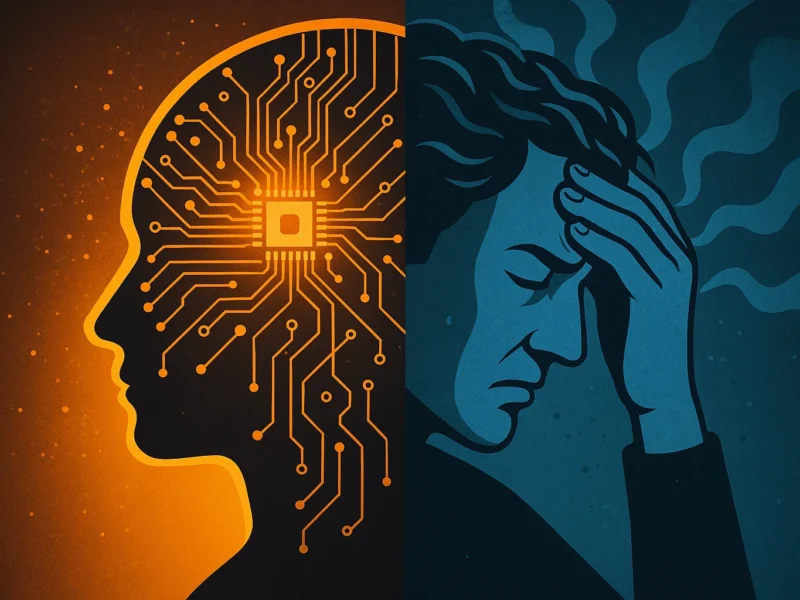Have you ever shut down the computer in the evening and feel your mind completely off, as if I had exhausted all the energy possible? Or start the day off already tired, knowing that you have an endless list of notifications, messages and deadlines digital? You're not alone. Burnout is the mental related to the excessive use of technology is a growing phenomenon, and is often underestimated.
In the hyper-connected world in which we live, the border between productivity and overload it is made thin. Smartphones, platforms, mail, dashboard, artificial intelligence: tools designed to make life easier can also become a source of constant stress, if used without knowledge.
What is burnout is mental and what is the role of technology
Burnout is a state of physical exhaustion and psychological, recognized by the World Health Organization as a syndrome linked to chronic stress from work. It is not only fatigue, but to a real loss of energy, motivation and concentration skills.
When the burnout is linked to the use of technology, we talk about burnout digital or burnout technology. This happens when the constant exposure to screens, notifications, and information flows becomes too intense, without appropriate breaks, without a filter, emotional or cognitive.
The mind enters a state of hyperactivated constant, with the long-term effects on your memory, on sleep, on the clarity and quality of the reports. One a study published in ResearchGateentitled “Digital Burnout: The Effect of Screen Workloads on Mental Health and Quality of Life”highlights how the excessive use of digital technology can generate an overload of mental significantly, altering the physical and mental wellbeing. The research stresses the importance of a conscious use of digital tools to prevent harmful effects on mental health, especially in work contexts.
Artificial intelligence can help or aggravate?
Like any technology, even AI can be both ally and enemy. On one hand, the tools based on artificial intelligence can lighten the mental workload by automating repetitive tasks, filtering information, suggesting priority. On the other, if they are used without criteria or in a compulsive way, run the risk of increasing pressure, instead of reducing it.
We think to virtual assistants, platforms productivity with notifications AI-driven systems of predictive analytics that require constant monitoring. If we don't learn to manage them with awareness, they become another source of anxiety.
But AI can also be part of the solution. Some apps time management today using intelligent algorithms to suggest when to take, how to reorganize the workflow, or how much actual time you're dedicating to each task. Platforms such as RescueTime or Clockwise really help to build a routine digital healthier.
Recognize the signs and prevent overloading
The first step is knowing how to recognize the signs of burnout technology. Irritability, difficulty sleeping, loss of motivation, a sense of confusion or disconnection emotional are alarm bells. But even the simple fact of not being able to “detach” it may be a symptom.
To prevent burnout-linked mental technology, serving small daily changes. Not always it is possible to reduce the use of digital tools, but you can change its approach. Use AI to automate only what you need, delete unnecessary notifications, build moments of disconnect, set time limits on digital tools.
In our article on as the AI can automate the flow of daily workwe have shown how some tasks may be delegated to the technology in an intelligent way, to retrieve the time and mental concentration. This is the point: don't get control of the instruments, but learn to control them you.
Concrete examples: how to counter it, with the help of technology
If you work all day at the computer, you can start with small gestures. Disable multiple notifications. Use an assistant to group email similar and only respond to the ones that matter. Organize your day with time blocks, and the moments of pause, using tools that help to keep the focus, as the Notion AI or Pomofocus.
Some professionals also incorporates app of meditation based on AI, as Balance or Mindfulness Coachadapt your sessions to your levels of stress. This is also a smart use of artificial intelligence: do not increase the pressure, but support you in moments of fatigue.
In our article on AI and neuroscience: in search of the mindwe have seen how the human brain reacts to the hyperstimulation digital. Neuroscience tell us clearly that the brain needs breaks, of cycles, of silence.
FAQ – frequently asked Questions
The burnout of mind is linked only to the digital workplace?
No. It can also be caused by emotional stress or load personal, but the technology, if used without a break, it can amplify it.
AI can help me really reduce stress?
Yes, if used to simplify the day and reduce loads repetitive. But it serves a use conscious and selective.
What happens if I ignore the symptoms of burnout?
In the long term, burnout is not treated, it can compromise the physical and mental health, in addition to the quality of the work.
There are early signs to be observed?
Yes: fatigue upon awakening, difficulty in concentration, motivation, hypersensitivity to stimuli digital.
Conclusion: the technology changes us, but we can choose how to
Burnout in mental caused by technology, it is a reality that is growing, but not unavoidable. It depends on how we choose to use the tools, how we listen to, to how much space to leave to the slow pace, to pause, to quality. Artificial intelligence can be a huge asset, if it is used with human intelligence.
Learn to recognize the signs, build, prevention strategies, and make technology an ally, not an enemy, is today one of the most important challenges of our time.
